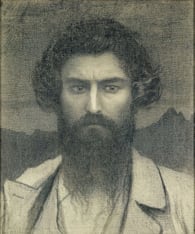
LUIGI GALLINA
Provenance
Rimini, private collection
Luigi Gallina was a Sicilian portraitist and caricaturist. He graduated from the Academy of Fine Arts in Naples as a student of Domenico Morelli, and completed his studies in Rome, where for eight years he attended the Institute of Fine Arts under the guidance of Domenico Prosperi. His contacts with Genoa, his adopted city, were important. There he was a frequent exhibitor at the exhibitions of the Società Promotrice delle Belle Arti, and those of the Associazione Alere Flammam (1919-1930), showing portraits of gentlemen and influential local dignitaries. He was also famous abroad for his portraiture, particularly in Britain (portraits of aristocrats and senior army officers). After his début in Naples in 1892, Luigi Gallina exhibited in Rome, 1897, at the Genoese “Promotrice” in 1899, and at the Salon de Paris in 1913.
In the pastel on paper presented here what stands out is not only the skilful hand of the portraitist who produced the work, but also and above all the intense face of the subject portrayed: Giovanni Segantini. Giovanni Segantini (1858 – 1899) was an extraordinary painter with a wild and impetuous character, yet at the same time poetic and scrupulous. Born in Arco di Trento of humble origins, Segantini managed to establish himself as one of the most talented painters of the Italian nineteenth century, despite his early death at only 41. Among the major exponents of Divisionism, from a certain point – somewhere around 1888 – in his works some evident Symbolist influences of a Nordic taste appeared and made Segantini’s art incredibly appealing and instantly recognizable.
In the portrait presented here, there is a great compositional affinity with the Self-Portrait which Segantini produced in 1895, preserved at the Segantini Museum of St. Moritz (FIG. 1). In it Segantini is depicted looking almost like a prophet. His face is seen from the front and recalls a Byzantine Christ. In fact, for the Symbolists, the artist was someone who replaced the established religions with his work. The mountains in the background are those of Maloja, in the Engadin Valley (Switzerland), where he had moved in 1894 to paint the vast alpine landscapes.

FIG. 1 - Giovanni Segantini, Autoritratto (Self-Portrait), 1895, charcoal with gold dust and traces of plaster on canvas, 58.5 x 49.5 cm, St. Moritz, Segantini Museum
The absence of any iconographic sources does not allow us to know why Luigi Gallina portrayed the Italian-Swiss artist. We can assume that the two met at the end of the 1890s. Having moved definitively from Naples to Genoa around 1896, Luigi Gallina may well have gone to visit Segantini in Maloja. The expert hand of Morelli’s pupil portrays the face of the divisionist artist in this work with extreme realism. The physiognomic closeness between the work presented here and Segantini’s Self-Portrait of 1895 allows us to assume that Gallina – known for being a first-rate portraitist – painted this portrait in those years.
This work could represent an act of respect for an artist for whom Gallina had profound admiration and with whom he had established a rewarding friendship.
Join the mailing list
Subscribe to our newsletter to receive all the news about exhibitions, fairs and new acquisitions!

